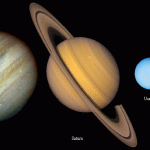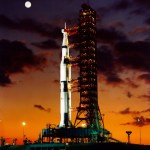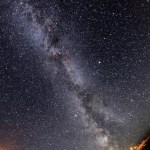Astronomy
Two notes from Caltech of interest:
Michael L. Roukes' group at Caltech has produced a NEMS (nanoelectromechanical system) device which can (almost) measure the mass of a single molecule (as opposed to the many tens of thousands (is this the correct amount?) needed in mass spectrometry.) Build a 2 micrometer by 100 nanometer NEMS resonator. Drop a molecule on it. The frequency of vibration of the NEMS resonator changes. Detect this frequency change. Of course vibration frequency also depends on where the molecule lands. So run the experiment about 500 times to get good estimate of the…
Although many of the best sites for eclipse viewing -- such as Shanghai, China -- were clouded out during this early morning, an old high school friend of mine in Taiwan had a chance to view an outstanding partial solar eclipse, which is something that most of us will get to see in our lifetimes.
While a total eclipse is typically only visible in a small region on Earth (where the blue swath is, above), a partial eclipse covers a much larger area (everywhere covered in red), where the Moon partially passes in front of the Sun.
When I was 15, I got to experience an 88% partial eclipse. With…
Today: July 20th, 2009. The 40th anniversary of the Apollo 11 moon landing. The very first time mankind walked on the Moon. From liftoff,
to walking down the lunar landing module for the first time,
to some of the most iconic images in all of human history:
It brings up a sense of wonder unlike any other before. This video by the onion is so funny to me because it really does capture that sense of awesomeness, and just how blown away those twelve men who got to walk on the Moon must have been:
And it's 40 years later now. While, scientifically, we understand more about outer space, the…
As someone who was born on a lunar eclipse (explains a lot, no?) the 40th anniversary of man walking on the moon has a special place in my heart. Okay, that sentence makes no sense (I was born on a lunar eclipse however), but anyway everyone is all abuzz about the anniversary of the moon landing so it's as good as any sentence to let me talk about booming sand dunes.
Booming whah?
Take a big sand dune. Kick some of the sand down the face of the dune. Sometimes, if you are lucky, the sand dune will emit a loud 70 Hz to 100 Hz booming sound. I used to have a sealed container of the booming…
I'll keep this simple, as you can get longer writeups at Universe Today, Bad Astronomy, and the NASA site, but a NASA spacecraft currently orbiting the Moon just released images of five of the six Apollo landing sites.
Why am I so excited about this? Because you can see the Earth-junk we left there! There's the lunar module from Apollo 11:
the one from Apollo 14 (Apollo 12 was out of the way, and Apollo 13 -- of course -- never made it onto the Moon):
and from Apollo 15:
Apollo 16:
and Apollo 17:
Go back to Apollo 14. There's something spectacular that you can see on the Moon in that…
The inner Solar System is a pretty bizarre place. Think about the giant planets in our Solar System -- the Jovian planets -- that weigh in from tens to hundreds the mass of Earth.
These giant balls of gas are orbited by all sorts of interesting things, from moons so giant that they have their own substantial atmospheres like Saturn's Titan:
to captured Kuiper Belt objects, like Neptune's giant moon, Triton:
to regular natural satellites that formed around the giant planets as they formed, such as Saturn's Dione and Enceladus:
All told, if we look at all the moons in the Solar System, the…
This is the coolest thing online I've seen in a long time. A team of amateur astronomers took over 1000 pictures of tiny areas of the Moon. 288 of them were chosen and mosaiced together. They describe the result far better than I do:
The end result is a high resolution 87.4 megapixel image of the Moon, larger even then previous images taken by some of the world's largest observatories, allowing features as small as 1km to be clearly seen.
This is the world's record for the largest mosaic of the Moon ever made, and it's available for you to view in full detail (!) at their site, Lunar World…
By the 1980s, our view of the Universe was pretty close to what it is today. We had confirmed the Big Bang Theory and even had some understanding of what must've caused the Big Bang. There were some mysteries around, such as dark matter, the age of the Universe, and the solar neutrino problem, but all in all, we were on pretty solid ground.
One of the things astronomers had been waiting for was a supernova to go off in our galaxy. We expect about one per century in our galaxy, and we hadn't seen one since 1604! It's 2009 now, and we still haven't seen one, but in 1987, we got closer than any…
We have come so far in the last 100 years, and so has our picture of the Universe. From an island galaxy ruled by Newton's gravity and classical electromagnetism, we've come through the discovery of general relativity, the expanding Universe, the need for dark matter, the big bang, the synthesis of all the elements in the Universe, and, for good measure, we walked on the Moon. By the 1970s, we had a fabulous picture of the History of the Universe.
There's just one (huge) problem: What caused the Big Bang? We know the laws of gravity and quantum mechanics, and we know that the Universe is…
Just a few weeks ago, the Herschel Telescope was launched into space and successfully deployed. Herschel is larger than the Hubble Space Telescope, but instead of measuring visible light, it measures far-infrared light.
This means that, when you look at any object in the Universe, the Hubble Space Telescope sees (mostly) visible light, or light between 400 and 700 nanometers. What gives off visible light? Stars, mostly, as well as some types of heated gas and dust. On the other hand, the light that Herschel sees is much cooler, between 55,000 and 672,000 nanometers.
Longer wavelengths mean…
There's no doubt that physics and astronomy was booming in the 1960s. The model that protons and neutrons were made of quarks was proposed and validated, the most powerful nuclear device of all time was detonated, and the Cosmic Microwave Background was discovered, validating the Big Bang. (Not to mention devastating advances in biology, too.)
But something far more awesome than that happened in 1969.
It not only trumps splitting the proton and confirming the Big Bang, it is -- for me -- the finest accomplishment in all of human history. And its 40th anniversary is exactly three weeks from…
Last week, I was lucky enough to get to host the Carnival of Space. This week, the honor goes to Jennifer Ouellette at Twisted Physics, and my article on the 1950s and Fred Hoyle gets top billing! There are a bunch of other highlights to check out. Here are my top 3 CoS picks of the week:
1. Ever what would have happened in the 1960s if the Apollo program had failed? Beyond Apollo takes an in-depth look at a secret backup plan from the RAND corporation that was NASA's number 2 option.
2. All planets that can support life may have their possibly habitable lifetimes greatly extended once life…
In the 1940s, the Big Bang theory was first conceived and detailed. But, to quote Niels Bohr,
We are all agreed that your theory is crazy. The question which divides us is whether it is crazy enough to have a chance of being correct. My own feeling is that it is not crazy enough.
One of the staunchest opponents of the Big Bang idea was Fred Hoyle, an outstanding, prolific scientist in his own right.
In the 1950s, Fred Hoyle found it inconceivable that all of the heavy elements in the Universe -- practically everything we find on Earth -- would have been made in the Universe's infancy. He…
We have a treat for you this week: Starts With A Bang gets to host this week's Carnival of Space! We take the best space and astronomy posts from around the internet and pull them together in one great extravaganza! I've gotten to host twice before, and this is a very special edition for astronomers. Why, you ask?
Yesterday was the Summer Solstice! Longest day of the year (for us Northern Hemisphere folk), most sunlight, the Sun gets highest in the sky, and shadows are the shortest. If you want to go all the way back, this was the day that allowed us to discover the Earth was round! Let's…
First light is one of the most important tests of any new telescope. It allows you to look at a well-known object, see if there are any problems with your telescope, and to get a small glimpse of how good your telescope is going to be.
Almost 20 years ago, we launched the Hubble Space Telescope. For its first light image, astronomers zoomed in on an area of the cluster NGC 3532, an open star cluster known as the Wishing Well Cluster:
(For all images in this post, you can click on them for a hi-res version.) From this one image, we were not only able to obtain incredible resolution on the…
There are many great discoveries that happened in the 1930s that changed our view of the Universe. From tiny discoveries (the neutron) to huge ones (Pluto), from theoretical explanations of antimatter to the neutrino to the start of quantum field theory, the 1930s were a great time for making new discoveries. But one man often gets left out of these discussions, IMO, because he was too far ahead of his time.
Meet Fritz Zwicky. Born in Bulgaria, a citizen of Switzerland, and did his best work at Caltech. (In fact, his daughter Barberina has noticed my old site!) Fritz was in the very tough…
This week at work, we're interviewing candidates for the job that I'm leaving. And one of the questions that came up was so simple and so fundamental to all that we do here that I thought I would ask it to you:
With all the problems in the world -- economic, political, social, and military -- what's the point of spending money on basic science? For example, why spend money looking for gravitational waves, the Higgs boson, or life on Mars?
Yes, these things are expensive. The total cost of LISA -- the space antenna that will look for gravitational waves -- is around 5 billion dollars; the cost…
The astro/physics blogosphere is all atwitter about papers the Nature embargo policy (See Julianne If a paper is submitted to nature does it still make a sound, the cat herder Hear a paper, see a paper, speak no paper, and he of less than certain principles Unhealthy obsessions of academia. He of uncertain principles loses the catchy title contest :) )
In this discussion, the uncertain principal brings up an interesting effect for arXiv postings:
There's an obsession in science with the order of publication that I don't think is really healthy, and I think it's only gotten worse. At the…
Just a short while ago, I showed you how the most powerful telescopes were able to gather incredible amounts of light from a tiny part of the sky, and peer deeper into the darkest regions of the Universe than ever before. But there's another way to do astronomy that's just as majestic: view the entire sky at once.
For an astronomer, this is easy; all you have to do is get a fisheye lens, and you can see an entire hemisphere with no problem. (The "up" hemisphere is much more interesting than the "down" one.) If you use it at night and take a time-lapse exposure, you can truly create some…















